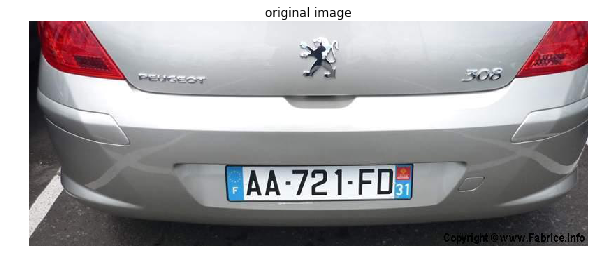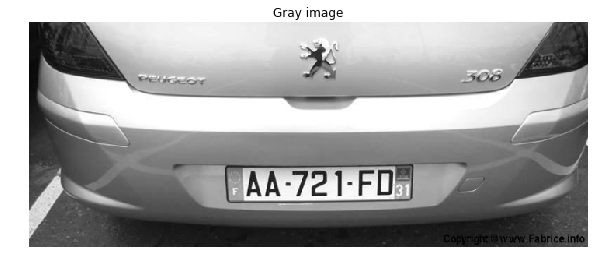Deep learning net surgery to create a feature map from a classification net
Let’s re-use our classifier net of license plate letters to see how it behaves as a feature map of images including more than one letter. Replacing the innerproduct layers with convolution layers with the same parameters will enable to create a feature map as on the left picture :

I’ll use Caffe’s python interface.
import numpy as np
import matplotlib.pyplot as plt
%matplotlib inline
from PIL import Image
import lmdb
import caffe
plt.rcParams['figure.figsize'] = (1, 1)
plt.rcParams['image.interpolation'] = 'nearest'
plt.rcParams['image.cmap'] = 'gray'Have a look at the training data
env = lmdb.open('test_lmdb')
t = ['A','B','C','D','E','F','G','H','I','J','K','L','M','N','O','P','Q','R','S','T','U','V','W','X','Y','Z','0','1','2','3','4','5','6','7','8','9'];
def get(k):
with env.begin() as txn:
raw_datum = txn.get(k)
datum = caffe.proto.caffe_pb2.Datum()
datum.ParseFromString(raw_datum)
flat_x = np.fromstring(datum.data, dtype=np.uint8)
x = flat_x.reshape(datum.channels, datum.height, datum.width)
y = datum.label
plt.imshow(x[0,...],cmap='gray')
plt.show()
print t[y]
get(b'00000006')
get(b'00000009')
D

5
Test the network for classification
caffe.set_mode_cpu()
net = caffe.Net('lenet_train_test_withoutdata.prototxt','lenet_iter_2000.caffemodel',caffe.TEST)
print("blobs {}\nparams {}".format(net.blobs.keys(), net.params.keys()))
im = np.array(Image.open('input/8.png'))
plt.title("original image")
plt.imshow(im)
plt.axis('off')will output
blobs ['data', 'conv1', 'pool1', 'conv2', 'pool2', 'dropout', 'ip1', 'ip2-alpha']
params ['conv1', 'conv2', 'ip1', 'ip2-alpha']
(-0.5, 27.5, 27.5, -0.5)

im.shape
im_input = im[np.newaxis, np.newaxis, :, :]
net.blobs['data'].reshape(*im_input.shape)
net.blobs['data'].data[...] = im_input
plt.rcParams['figure.figsize'] = (10, 10)
out = net.forward()
plt.figure()
filt_min, filt_max = net.blobs['conv1'].data.min(), net.blobs['conv1'].data.max()
for i in range(9):
plt.subplot(1,10,i+2)
plt.title("filter #{} output".format(i))
plt.imshow(net.blobs['conv1'].data[0, i], vmin=filt_min, vmax=filt_max)
print("The result is {}".format(t[out['ip2-alpha'].argmax()]))The result is B

#Feature map
Let’s cast the innerproduct layers ‘ip1’ and ‘ip2-alpha’ into convolution layers ‘ip1-conv’ and ‘ip2-alpha-conv’ :
!diff lenet_train_test_withoutdata.prototxt lenet_train_test_featuremap.prototxt
1c1
< name: "LeNet"
---
> name: "LeNetConv"
82,83c82,83
< name: "ip1"
< type: "InnerProduct"
---
> name: "ip1-conv"
> type: "Convolution"
85,92c85,86
< top: "ip1"
< param {
< lr_mult: 1
< }
< param {
< lr_mult: 2
< }
< inner_product_param {
---
> top: "ip1-conv"
> convolution_param {
94,99c88
< weight_filler {
< type: "xavier"
< }
< bias_filler {
< type: "constant"
< }
---
> kernel_size: 1
105,106c94,95
< bottom: "ip1"
< top: "ip1"
---
> bottom: "ip1-conv"
> top: "ip1-conv"
109,119c98,102
< name: "ip2-alpha"
< type: "InnerProduct"
< bottom: "ip1"
< top: "ip2-alpha"
< param {
< lr_mult: 1
< }
< param {
< lr_mult: 2
< }
< inner_product_param {
---
> name: "ip2-alpha-conv"
> type: "Convolution"
> bottom: "ip1-conv"
> top: "ip2-alpha-conv"
> convolution_param {
121,126c104
< weight_filler {
< type: "xavier"
< }
< bias_filler {
< type: "constant"
< }
---
> kernel_size: 1
params = ['ip1', 'ip2-alpha']
# fc_params = {name: (weights, biases)}
fc_params = {pr: (net.params[pr][0].data, net.params[pr][1].data) for pr in params}
for fc in params:
print '{} weights are {} dimensional and biases are {} dimensional'.format(fc, fc_params[fc][0].shape, fc_params[fc][1].shape)outputs
ip1 weights are (500, 800) dimensional and biases are (500,) dimensional
ip2-alpha weights are (36, 500) dimensional and biases are (36,) dimensional
# Load the fully convolutional network to transplant the parameters.
net_full_conv = caffe.Net('lenet_train_test_featuremap.prototxt','lenet_iter_2000.caffemodel',caffe.TEST)
params_full_conv = ['ip1-conv', 'ip2-alpha-conv']
# conv_params = {name: (weights, biases)}
conv_params = {pr: (net_full_conv.params[pr][0].data, net_full_conv.params[pr][1].data) for pr in params_full_conv}
for conv in params_full_conv:
print '{} weights are {} dimensional and biases are {} dimensional'.format(conv, conv_params[conv][0].shape, conv_params[conv][1].shape)outputs
ip1-conv weights are (500, 50, 1, 1) dimensional and biases are (500,) dimensional
ip2-alpha-conv weights are (36, 500, 1, 1) dimensional and biases are (36,) dimensional
for pr, pr_conv in zip(params, params_full_conv):
conv_params[pr_conv][0].flat = fc_params[pr][0].flat # flat unrolls the arrays
conv_params[pr_conv][1][...] = fc_params[pr][1]
net_full_conv.save('lenet_train_test__full_conv.caffemodel')
plt.rcParams['figure.figsize'] = (10, 5)
im = np.array(Image.open('input/p1.jpg'))
plt.title("original image")
plt.imshow(im)
plt.axis('off')
im.shape #(322, 800, 3)
import cv2
im_gray = cv2.cvtColor(im,cv2.COLOR_BGR2GRAY)
im_gray = cv2.resize(im_gray,None, fx=0.9, fy=0.9, interpolation = cv2.INTER_AREA)
plt.title("Gray image")
plt.imshow(im_gray)
plt.axis('off')
im_gray.shape #(290, 720)
im_input = im_gray[np.newaxis, np.newaxis, :, :]
net_full_conv.blobs['data'].reshape(*im_input.shape)
net_full_conv.blobs['data'].data[...] = im_input
out = net_full_conv.forward()
out['ip2-alpha-conv'].shape # (1, 36, 70, 177)
# show net input and confidence map (probability of the top prediction at each location)
plt.subplot(1, 2, 1)
plt.imshow(net_full_conv.blobs['data'].data[0,0])
plt.subplot(1, 2, 2)
plt.imshow(out['ip2-alpha-conv'][0,0] )
Here we are !